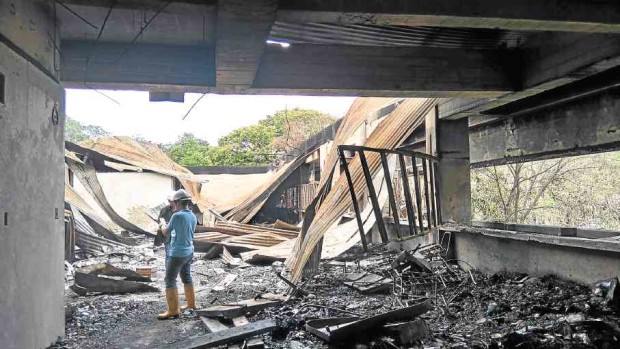
The 10-hour fire that hit UP Faculty Center on April 1, 2016, destroyed not only a 5-decade-old structure but also a rich trove of academic papers, research works and art pieces.
A year after the devastating fire that engulfed the Faculty Center on the University of the Philippines campus in Diliman, Quezon City, the UP community, while still nursing a great sense of loss, has also taken the first steps toward rebuilding.
What the 10-hour blaze destroyed on April 1, 2016, was more than just a home for UP professors and a venue for discourse. Considered the nerve center of the university, the “FC”
—formally called Bulwagang Rizal—was a time capsule that linked the current students and faculty to the luminaries who once walked its halls, including National Artists Francisco Arcellana, Lino Brocka and Amado V. Hernandez, among others.
For the teachers, the fire took away not only lesson plans and teaching materials. When Kerby Alvarez, an assistant professor of history, first learned about the fire on Facebook past midnight of April 1, he thought it was just an April Fools’ Day joke.
“But then I saw the fire trucks coming in … so I grabbed my bike and went directly to FC (from my dormitory),” he told the Inquirer. “Even from afar, I knew it was a fire that would leave us with nothing.”
The proposed design of the P300-million Faculty Commons—PHOTOS COURTESY OF Enrico Tabafunda/UP-Diliman Office of the Campus Architect
The fire broke out around 1:20 a.m. on the third floor and reached Task Force Alpha, an alert level requiring at least 50 fire trucks.
One of the first to arrive at the scene, Alvarez frantically called up colleagues, rousing them from sleep with the terrible news. Fellow professors would later see the young educator crying in front of the burning building.
“We considered FC a safe place … Many of us found it better to leave our things there,” said Alvarez, who lost his books, gadgets, hard drives containing research from fieldwork in different countries, his passport, and all his university diplomas.
Days later, as Alvarez and his peers entered the ruins, he managed to salvage a jar full of charred P5 coins. The sad souvenir now sits in the cabinet of his new office.
Months before the fire, he recalled, the various departments housed in the FC had been working on digitizing their collections. The history department, for example, had decided to make digital copies of all the master’s and doctorate dissertations of its students from the 1950s to the 1960s.
Place of resistance
The anthropology department, meanwhile, had a rare collection of works by H. Otley Beyer, considered the Father of Philippine Anthropology.
“But the fire got to them first,” Alvarez said.
Officials estimated the damage to be around P30 million. But for UP Diliman Chancellor Michael Tan, the treasures that went up in flames could not just be weighed in monetary terms. “Faculty members are producers of knowledge, and their research notes, thoughts, lessons plans, artworks and even cassette tapes from fieldwork—these are all incalculable,” Tan said.
Inaugurated in September 1969, the FC evolved into a place of resistance within the university, especially during the Marcos dictatorship.
The Bulwagang C.M. Recto, a circular conference room, served as the center’s beating heart, receiving newly released political prisoners as special guests and hosting lively discussions, with topics ranging from literature to the US military bases.
Hoping to recapture this spirit of place, Tan said a new building would soon rise from FC’s ashes—and it would be called Faculty Commons.
Unlike the old building that housed faculty rooms, the proposed structure will have seminar rooms, conference and exhibit halls, faculty lounges and reception areas for socials.
For P300 million
But over and above these improvements, the engaging, embracing character of Bulwagang C.M. Recto would be retained. “We want to build the soul first, because it feels like UP has lost its soul ever since the fire,” Tan said.
The new structure is expected to cost around P300 million. When demolition works started clearing and preparing the site on Monday, UP Diliman had so far raised P150 million—half of the amount drawn from the General Appropriations Act, the other from the UP System.
The 250 faculty members and around 50 staff members affected by the April 2016 fire have since been given new offices in the renovated pavilions of the College of Social Sciences and Philosophy, and at the Acacia Residence Halls.
In two years, Tan said, professors from the College of Arts and Letters are expected to make a complete transfer to Melchor Hall, which used to house the campus’ engineering complex.
More steps are also being done to fireproof the university, which has suffered several fires since 2015, including the blaze that gutted the Casaa Food Center and the UP Alumni Center.
Within the year, UP Diliman is expected to have its own fire station.
But even with these developments, the “healing stage” at the country’s premier state university would still take some time, Tan said. “There is still a lot of sadness and bitterness. But I think it is best to keep reassuring people that FC will rise again.”